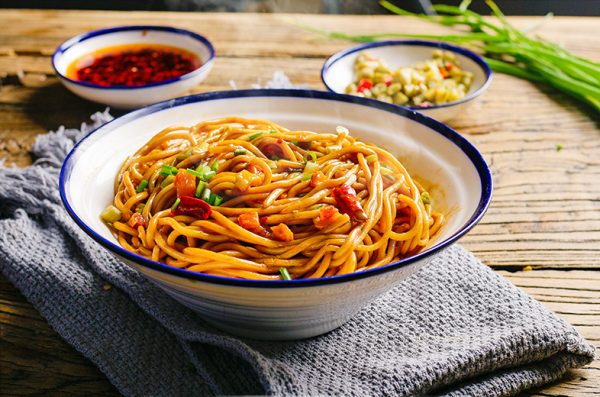
Wuhan hot dry noodles (Wǔhàn rè gān miàn 武汉热干面) has been a favorite of Wuhan’s culinary culture since the 1930s. Although more recent than other traditional noodle dishes, this popular breakfast fare from Hubei’s capital, is noted for its simple cooking method and its rich flavours that combine spicy, salty, sour and nutty tastes.
Wuhan has long and hot summers, and in order to preserve food, the locals pickle vegetables, smoke and cure meats, and use alkaline water to add texture to their noodles. You can find all these ingredients and techniques in Hot Dry Noodles.
Hot Dry Noodles literally refers to how the dish is served. ‘Hot’ Rè 热, means the noodles will be served hot and steaming, ‘Dry’ Gān 干, indicates there’s no soup in the noodles. ‘Noodles’ Miàn 面, refers specifically to wheat-based noodles.
One interesting aspect of these noodles is the use of alkaline water in their preparation. They are called Jiǎn Shuǐ Miàn碱水面. If you cannot find them, you can substitute them with fresh Ramen or dried noodles.
Other than noodles, this dish contains pickled dried radishes, mustard roots, sour pickled beans, chili oil and sesame paste.
Let’s see how to cook this simple, yet mouthwatering dish:
Serves 4
Ingredients:
400g dried noodles 挂面 guà miàn*
100g pickled spicy radish 辣萝卜干 là luóbo gān
100g pickled sour beans 酸豆角 suān dòujiǎo
4-5 tbsp sesame paste* 芝麻酱 zhīmajiàng *
4 tsp dark soy sauce 老抽 lǎo chōu
4 tsp chili oil 辣椒油 làjiāo yóu*
4 -5 tbsp stock (chicken or vegetable)* 卤水 lǔshuǐ*
4-5 tbsp sesame oil 香油 xiāngyóu
4 stalks spring onion green part 小葱叶 xiǎocōngyè
4 stalks spring onion white part 葱白 cōngbái
4 cloves garlic 蒜 suàn
1-2 tsp salt or according to taste 盐 yán
1 pinch white pepper powder 白胡椒粉 bái hújiāo fěn
1-2 tsp sugar or sugar according to taste 糖 táng
1/2 cup vegetable oil 植物油 zhíwùyóu
Water to boil the noodles 水 shuǐ
Chicken or vegetable stock (can be substituted by using water)*
250g chicken thigh or mushroom (vegetarian option) 鸡腿/ 蘑菇 jītuǐ /mógū
4 pieces of spring onion white part 葱白 cōngbái
3 pieces garlic 蒜 suàn
5g ginger in pieces 姜 jiāng
1 tsp fennel seeds 茴香籽 huíxiāngzǐ
2 bay leaves 香叶 xiāngyè
1tsp Sichuan peppercorn 花椒 huājiāo
1 piece of cardamom 草果 cǎoguǒ
1 small piece cinnamon 肉桂 ròuguì
1 tsp cooking wine 料酒 liàojiǔ
1tbsp dark sauce 老抽 lǎochōu
1-2 tsp sugar or according to taste 糖 táng
Chili oil
4 tbsp chili powder
6-8 tbsp vegetable oil
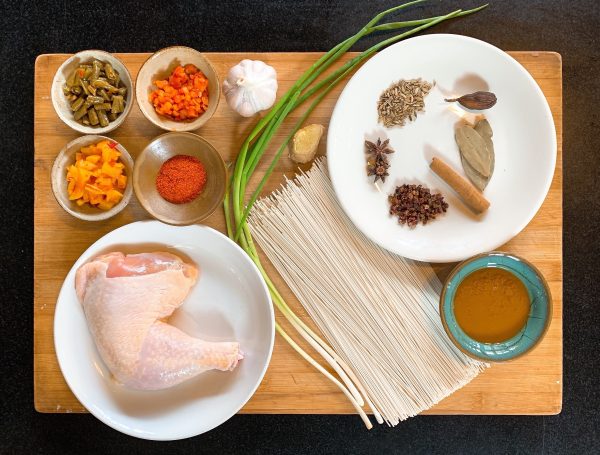
Method:
Chop the pickles into small pieces for later use.
Garlic water: mince 4 cloves of garlic and soak in about 4-6 tbsp of warm water for later use.
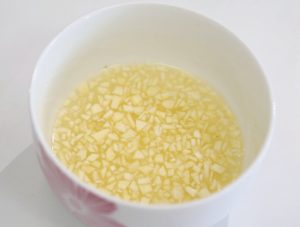
Separate spring onion white part and green part. Put the white part aside, and slice the green part into small pieces, but do not mince the leaf-part of the green stalk. Slice the ginger into thick pieces.
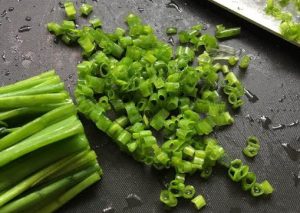
The stock:
Heat up 2 tbsp of oil at low heat. Add spring onion’s white part, sliced garlic and ginger pieces. Fry until fragrant. Add the cooking wine. Then add all the dried spices: Sichuan peppercorn, bay leaves, fennel seeds, cardamom, cinnamon. Fry for about 30 seconds. Add 2 cups of water. Mix in dark soy sauce and sugar. Then add the chicken thigh or mushrooms and bring to boil. Take away any foam and simmer for about half an hour. Strain all the ingredients from the stock and leave the stock for later use. Chicken can be served as a side dish.
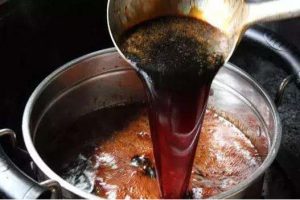
The Chili Oil:
Put the chili powder in a ceramic bowl. Heat oil in wok at medium heat. When the oil starts to smoke, turn the flame off. Add the hot oil to the dried chili powder with a spoon, one spoon at a time, all the while stirring oil and chili powder.

Boil the noodles:
Bring a pot of water to a boil. Add a teaspoon salt. Add the dried noodles into boiling water for about 2 minutes until half-cooked. Drain the noodles into a colander. Quickly add the vegetable oil to the noodles. Toss the noodle thoroughly making sure they do not stick. Let them cool down completely.
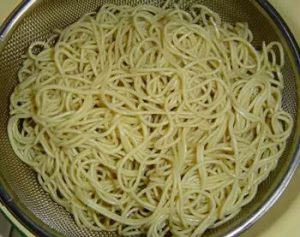
The sauce:
Mix sesame paste and sesame oil together until the mixture becomes smooth and liquid. Add dark soy, salt, sugar according to taste.

Boil the noodles (again):
Bring a pot of water to a boil again. Add again the cool noodles to boiling water for 30 sec – 1 min. according to taste. Drain them and place them into 4 bowls.
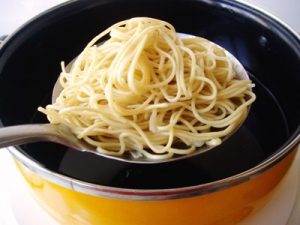
Combine everything together and serve:
Put the pickled radishes and sour beans, sliced spring onion (green part), and garlic water on the top of noodles. Pour 2-3 tbsp of sesame paste sauce on top, and 1-2 tbsp of stock. Mix well, making sure noodles are covered with sauce. Serve warm.
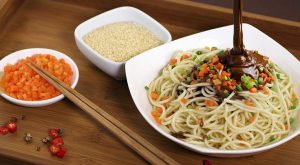
Notes:
Noodles: Authentic Re Gan Mian noodles recipe requires alkaline noodles which are very easy to find in Wuhan but not in Beijing. Our recipe uses dried noodles instead as they’re similar in texture. For more information on alkaline noodles, please click here.
Stock: In Wuhan, locals usually use beef to make the stock, boiling it at low flame for over 90minutes. A vegetable stock can be made as a substitute, using assorted vegetables or just mushrooms, boiling it at low flame for 30 minutes.
Sesame paste: In China, sesame paste is made from roasted sesame and sometimes mixed with peanut paste. Making Chinese sesame paste is different from Tahini. In Wuhan, locals often use black sesame paste for this dish and sesame oil to thin the paste. If it is not easy for you to find the sesame paste, you can use peanut butter instead. If you don’t want to have too much oil in the noodles, you can use less sesame oil and add more water to thin the paste. Here is the link for more information about Chinese sesame paste.
For more Re Gan Mian cooking tips please look here.
For more information, please contact us.
Email: info@thehutong.com Mobile & Wechat: 15901046127
We look forward to seeing your delicious entries













